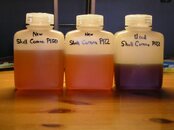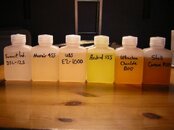swamp diver
Contributor
Actually I have noted that with a few petroleum based oils locally. Here mineral (or petroleum based) oils are used extensively and I often used to see a colour difference when purchasing, (ie) darker... especially when purchased in smaller quantities usually in clear or semi transparent plastic bottles, obviously decanted by the supplier from the larger original drums.
Later I bought the oil in drum form from the manufacturer and found the original manufacturers drums were a very dense plastic, yellow or black in colour which obviously prevented sunlight reaching the oil, and oil stored in these drums even for extended periods of 8 months or more never darkened or changed colour.
I often wondered if the colour change signified a certain degradation of some of the additives in the oil and I asked quite a few people about it, but in general the consensus was "No", although I could never find any firm conclusive evidence to prove the colour change was detrimental to the oil, by the same token, I could never really find any evidence to prove it wasn't either.
I would be interested to hear what would be your take, or the boards opinion on this.?
Very good questions.
In general as an oil is exposed to the ambient environment it will slowly oxidize and turn darker. The rate of this color change really depends on the storage conditions which include ambient temperature cycling, the volume of air sitting above the oil, and the anti-oxidant additive(s) treat rate.
Almost all the oils will have at least one or two anti-oxidants added to the base oil in order to slow down the rate of oxidative degradation. The rate of degradation will be higher if you store the oil at higher temperatures or if it is not stored in a climate controlled facility in order to avoid temperature cycling. It is best stored at 20 C rather than being exposed to -15 C to 30 C outdoors in the garage.
Also unopened containers with very little air on top of the oil will oxidize at a much slower rate than a container that is only half full so if you are using the oil at a slow rate it would be better to transfer the oil from a 45 gallon drum to 4 gallon pails in order to reduce the amount of air exposure.
Ultraviolet exposure will also darken the oil but this is generally not significant.
The question really comes down to how long is the shell-life for the various oil types. You'll find various opinions on this but most manufacturers will tell you 10 years for an unopened synthetic (the oil will be much darker at 10 years) and probably 2 years for a mineral oil. We actually did look at the rate of degradation of mineral oils and were quite surprised to find that the oil stored outdoors in a 45 gallon drum which was half full and two years old at the time of sampling had lost all of its additive package either through degradation within the mineral oil or possibly evaporation. This also explained the poor oil analysis results we were obtaining at the end of the oil change interval from the compressor.
I'd say therefore that a slight darkening of the oil over time is not significant, but leaving your mineral oil in a half full 45 gallon drum at 30 C will be after a year or more. Keep the oil at 20 C and reduce the container size over time to minimize air exposure and you'll likely get 2 to 3 years shelf life from the oil. If you are unsure send a new sample of oil and the older sample to the lab and look at the ICP metals which are in the additive packages. Once these are at 75% of the new oil's values you know the oil has just about reached its best before date.
In these pics you can see that the color of the new synthetic oils vary considerably so the color change with normal aging will also vary. The mineral oils such as the Shell Corena P122 and P150 are generally darker to begin with since these oils are refined from crude oil.
The compressor environment is essentially like an oxidative test bomb with the water, heat, high ppO2, and iron wear products. As a result both the mineral and synthetic oils will show thermal and oxidative degradation at a higher rate making the oil much darker as can be seen in the used Corena mineral oil after 3 months of use.







